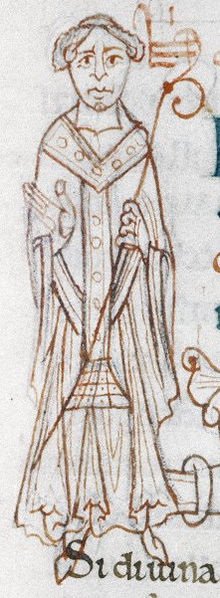Lanfranc (nonfiction): Difference between revisions
Jump to navigation
Jump to search
No edit summary |
|||
| (One intermediate revision by the same user not shown) | |||
| Line 1: | Line 1: | ||
[[File:Lanfranc_circa_1100.jpg|thumb|Lanfranc circa 1100.]]'''Lanfranc''' (Latin: Lanfrancus; Italian: Lanfranco; 1005 x 1010 at Pavia — 24 May 1089 at Canterbury) was a celebrated Italian jurist who renounced his career to become a Benedictine monk at Bec in Normandy. | [[File:Lanfranc_circa_1100.jpg|thumb|Lanfranc circa 1100.]]'''Lanfranc''' (Latin: Lanfrancus; Italian: Lanfranco; 1005 x 1010 at Pavia — 24 May 1089 at Canterbury) was a celebrated Italian jurist who renounced his career to become a Benedictine monk at Bec in Normandy. | ||
He served successively as prior of Bec Abbey and abbot of St Stephen in Normandy and then as archbishop of Canterbury in England, following its Conquest by William the Bastard. | He served successively as prior of Bec Abbey and abbot of St Stephen in Normandy and then as archbishop of Canterbury in England, following its Conquest by William the Bastard. | ||
| Line 7: | Line 5: | ||
He is also variously known as Lanfranc of Pavia (Italian: ''Lanfranco di Pavia''), Lanfranc of Bec (French: ''Lanfranc du Bec''), and Lanfranc of Canterbury (Latin: ''Lanfrancus Cantuariensis''). | He is also variously known as Lanfranc of Pavia (Italian: ''Lanfranco di Pavia''), Lanfranc of Bec (French: ''Lanfranc du Bec''), and Lanfranc of Canterbury (Latin: ''Lanfrancus Cantuariensis''). | ||
== | == In the News == | ||
<gallery mode="traditional" widths="200px" heights="200px"> | |||
Canterbury_scrying_engine.jpg|link=Canterbury scrying engine|[[Canterbury scrying engine]] computes new program based on life of Lanfranc. | |||
</gallery> | |||
== Nonfiction cross-reference == | == Nonfiction cross-reference == | ||
Latest revision as of 07:02, 18 December 2016
Lanfranc (Latin: Lanfrancus; Italian: Lanfranco; 1005 x 1010 at Pavia — 24 May 1089 at Canterbury) was a celebrated Italian jurist who renounced his career to become a Benedictine monk at Bec in Normandy.
He served successively as prior of Bec Abbey and abbot of St Stephen in Normandy and then as archbishop of Canterbury in England, following its Conquest by William the Bastard.
He is also variously known as Lanfranc of Pavia (Italian: Lanfranco di Pavia), Lanfranc of Bec (French: Lanfranc du Bec), and Lanfranc of Canterbury (Latin: Lanfrancus Cantuariensis).
In the News
Canterbury scrying engine computes new program based on life of Lanfranc.

